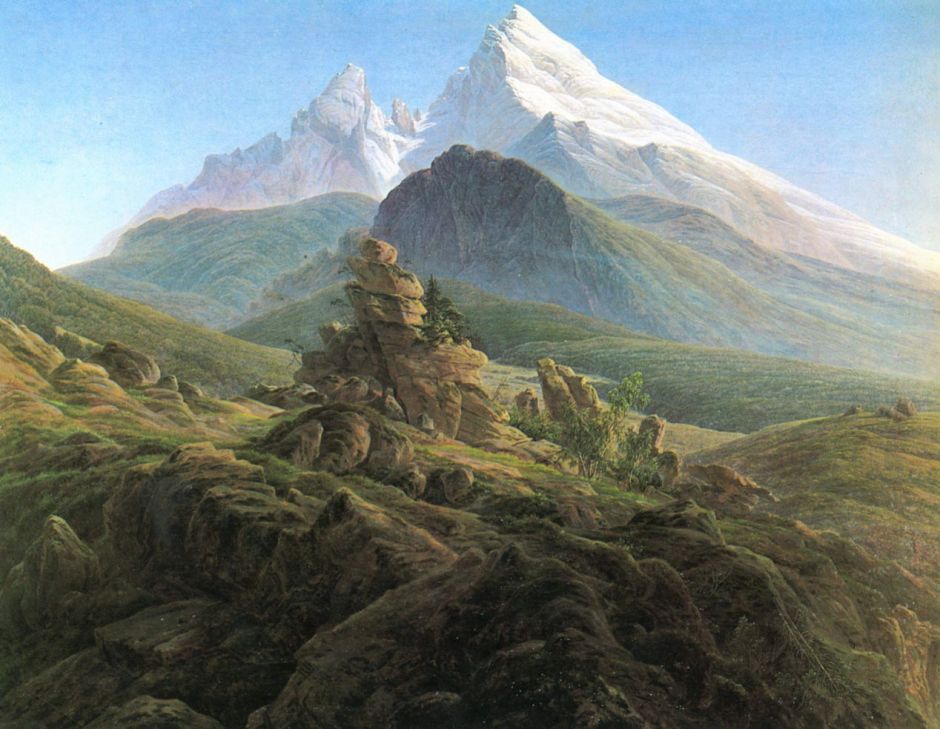Although it’s possible to travel overland from the north of Europe to Italy without ascending much above sea level, those privileged enough to undertake the Grand Tour more usually crossed the Alps on their journey. From the late seventeenth to mid-nineteenth centuries it was often their first exposure to real mountains. It was also a section that lent itself to souvenirs in the form of paintings intended for tourists. So it was that Swiss painters first came to specialise in selling their works to the gentry from the lowlands of Britain, northern France, the Low Countries and Germany.
Among the first was Caspar Wolf, born in Switzerland and trained in Konstanz. In 1769, he moved to Paris, where he worked with Philip James de Loutherbourg, before the latter went to London and became famous for his maritime paintings and industrial scenes, such as Coalbrookdale by Night (1801).

Wolf’s break came in 1774, when he moved to the city of Bern and made a deal to deliver two hundred paintings to a local publisher. Among these was this Panorama of Grindelwald with the Wetterhorn, Mettenberg and Eiger (1774), which is an unusually wide-angle view from what was then little more than a village.

He moved closer into the foot of the ice to paint The Lower Grindelwald Glacier with Lütschine and the Mettenberg, presumably during the same visit. The scale of the ice cliffs here is given by the small group of figures who have walked up to gaze into its caverns.

He travelled around the Alps steadily working through his contractual commitment. By 1776, he had painted this view of The Lauteraar Glacier, also in the Bernese Alps. The large tabular rock was a popular spot for more adventurous tourists to sit and become inspired by the Burkean sublime of the ice and mountains around them.

One of his most popular paintings was this view of the Devil’s Bridge in the Saint Gothard Pass, from 1777. This pass connects northern and southern Switzerland, and this section has been of great strategic importance. This bridge across the Schöllenen Gorge was first built in wood in around 1220, and was a key section of the route. It probably wasn’t replaced by a stone bridge until the seventeenth century, and by 1775 it had developed into that shown here, wide enough to allow passage of the first carriages.

Less than thirty years later, JMW Turner exercised his imagination and exaggerated vertical scale in this famous view from the bridge.
Like Turner, Caspar David Friedrich was born on coastal lowlands but later came to appreciate the mountains.

Friedrich’s painting of The Watzmann from 1824-5 shows the third highest peak in Germany, to the south of the village of Berchtesgaden, in the Bavarian Alps. Friedrich’s painting appears to show the mountain and its environs quite faithfully, although all signs of human habitation (including perhaps the village itself) have been replaced by rocky and barren land.
Friedrich and his followers replaced small groups of tourists with the novel figure of the wanderer, who became something of an obsession of the Anglo-Norwegian artist Thomas Fearnley. During the 1830s he wandered alone around Europe, crossing the Alps at least twice. He became one of the most brilliant exponents of plein air painting in the mountains, and many of his paintings featured the wanderer.

During his travels in about 1837, Fearnley visited the Grindelwald Glacier, and produced this superb plein air oil sketch. In addition to the ghostly-white eagle soaring above the ice, he included more than half a dozen figures, shown in the detail below.

Prominent among the nearer group is a walker, wearing a large black hat. Even the line of people far back against the foot of the glacier has been painted in some detail, though, with the leader holding a staff, and one of them mounted on a pony or similar.

A year or so later, Fearnley painted this large finished version. The method he used to transfer from his original sketch has reversed the sides of the image, but many details have been retained. The eagle still soars, the trees are very similar, but the figures have changed completely.

On the now lush pastures in front of the massive wall of ice, Fearnley has found a flock of sheep instead of people. In the distance, with his back towards us, is the wanderer, posing as shepherd but looking away from the viewer, towards the glacier, and wearing a distinctive black hat.
The most successful at catering for the tourist market was the Swiss artist Alexandre Calame, who was born on the shore of Lake Geneva in a town that now houses the worldwide headquarters of Nestlé. When he was just sixteen, his father was killed in an accident, and the young Alexandre had to start bringing money into the family by colouring black and white engravings to sell to tourists. Three years later his talents were spotted by a banker who became his first patron, and he started learning to paint with the great Swiss landscape artist François Diday.

Eventually Calame’s fine studio paintings of the mountains and lakes of Switzerland became famous throughout Europe. His finished View of Lake Geneva from 1849 includes some people and the distinctive sailing boats of the Swiss lakes, with one small bird in the shallows.

Vierwaldstättersee from the same year is an elevated view of Lake Lucerne showing the mountains beyond.

Calame also painted some of the well-known peaks, including The Jungfrau, Switzerland (1853-55). This 4,158 metre (13,642 feet) mountain in the Bernese Alps had only received its first ascent in 1811, and was still well off the beaten track. Calame views it from the bottom of the Lauterbrunnen Valley, another mountain torrent in full spate, with broken trees nearby to demonstrate the wildness of nature.
By that time, some of the more intrepid tourists were being guided up those Alps, as well as buying paintings to take home as trophies.

